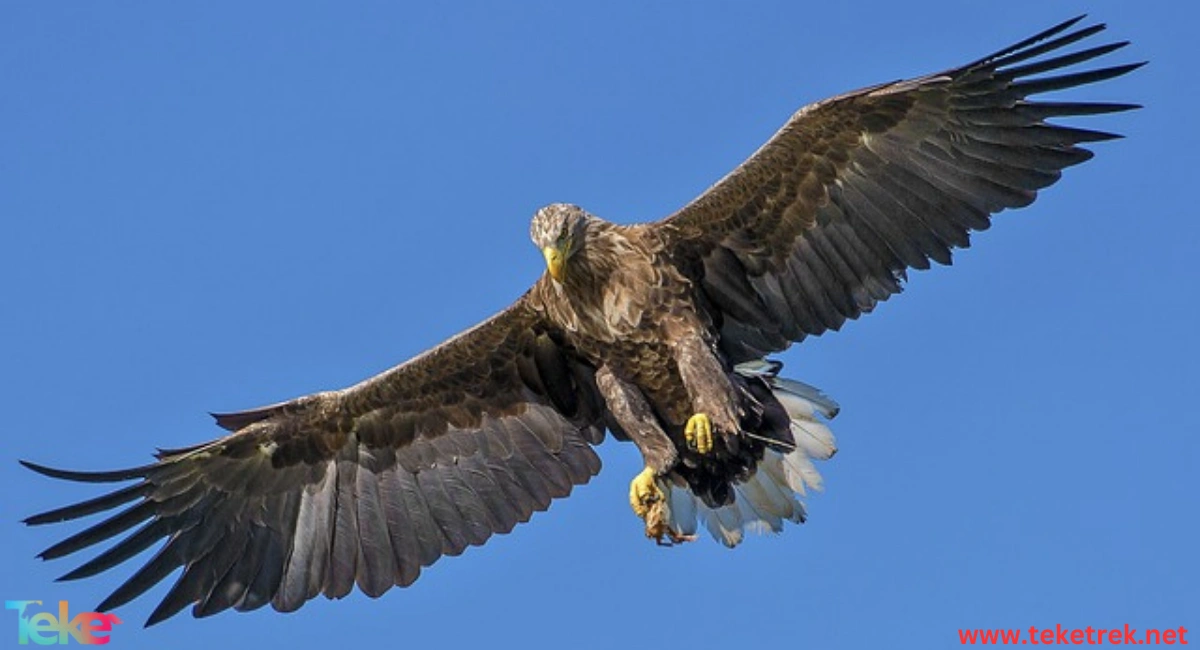Golden eagles are known for their large size and beauty, and are divided into several types:, and amazing aerial skills. It is one of the most famous eagle species globally and is considered one of the best hunting birds of prey. The Golden Eagle belongs to the genus “Aquila chrysaetos” and has a rich historical origin, holding an important place in many ancient cultures.
Let’s learn more about it from teketrek.

Key Characteristics of the Golden Eagle:
The Golden Eagle has a strong and massive body with long wings, allowing it to fly for long periods without stopping. It has brown feathers with light golden gradients on the neck. Its young are distinguished by their white tails and white markings on their wings.
It also has a large head, a strong beak and large eyes.
Its length ranges from 66 to 102 cm, while its wingspan reaches from 185 to 220 cm, making it one of the largest birds of prey.
The male weighs between 3-4 kilograms, while the females can weigh up to 5-6 kilograms.
It can live for many years in the wild, ranging from 25 to 30 years.
The Golden Eagle has sharp and strong vision, capable of seeing its prey, even if it’s a small animal like a wild rabbit, from a distance of up to two kilometers.
Thanks to its wide eyes that reflect a larger and clearer image on its retina, its eyes are characterized by a high density of light-sensitive cells, which increases the accuracy of the image it sees. Each eye contains two central apertures that act as light receptors, allowing it to focus on its target exclusively. This feature enables it to achieve precise focus on its prey.
It possesses a circular muscle around each eye that stabilizes the lens when swooping, maintaining clear vision. Additionally, it can rotate its head up to 270 degrees, significantly expanding its field of vision.
The Golden Eagle looks majestic due to its distinctive eyebrows, which protect its eyes from the sun’s glare and maintain eye cleanliness with a transparent eyelid that shields them from dust and debris during flight or swooping. This remarkable ability to see in color enables it to easily distinguish living things.
Its cruising flight speed is between 45-52 kilometers per hour, but when chasing prey, its speed can reach up to 190 kilometers per hour. During descent towards prey, it can reach speeds ranging from 240 to 320 kilometers per hour, making it one of the fastest birds and animals on Earth.
Golden Eagle location
The Golden Eagle is found in diverse geographical areas such as mountainous regions, deserts, forests, and grasslands around the world.
It exists in the northwestern part of North America, the northern regions of Europe, Asia, and North Africa, with the largest populations concentrated in Alameda County, California, USA. Its locations may change according to the seasons or the surrounding environment.
Reproduction of the Golden Eagle:
The Golden Eagle is a monogamous bird, sticking with one partner throughout its life. The breeding process usually begins in spring, where the pair builds a large nest, typically in high mountainous areas or on tall trees.
Females lay between 1 to 4 eggs during the breeding season and protect and warm them for 6 weeks until they hatch.
The mother cares for the young, which typically only one or two survive, until they gain the ability to fly and hunt independently. This process lasts for about 3 months before the young are able to live independently.
The abundance of available prey is the basis for successful chick rearing.
Uses of the Golden Eagle:
It plays an important role in many traditional cultures and societies, where it was considered a symbol of strength and honor and was used in hunting and war in some ancient cultures.
In modern times, it is used in military training in some countries for specific tasks such as chasing drones, and it is considered a national symbol in some states, like Utah in the United States.
In ancient times, it was believed to be a symbol of the gods and power, appearing in many ancient symbols, drawings, and the national flags of various cultures.
Golden eagle diet
Golden Eagles use their culture and speed, along with their large, sharp talons and strong feet, to hunt a variety of animals such as rabbits, squirrels, foxes, and larger animals like deer and seals.
Behavior of the Golden Eagle When Facing Threats:
This includes spreading wings and swinging the tail or flipping onto the back with extended talons for defense. When a threat approaches, the eagle tends to move away, lowers its head, and remains calm. Females sometimes exhibit more aggressive behavior, especially against intruders of other species.
Types of Golden Eagles:
Golden Eagles are a subspecies of eagles characterized by large size and beauty, and they are divided into several types:
1. European Golden Eagle (Aquila chrysaetos chrysaetos):
Found throughout Europe and European Russia, characterized by a medium size and blond golden feathers.
2. Iberian Golden Eagle (Aquila chrysaetos homeyeri):
Located in the Iberian Peninsula and North Africa, it is smaller and darker in color than the European Golden Eagle.
3. Asian Golden Eagle (Aquila chrysaetos daphanea):
Found in the Himalayas and the Far East of Russia, it is the largest and darkest in color among the types.
4. Japanese Golden Eagle (Aquila chrysaetos japonica):
Located in northern Japan and part of Korea, it is the smallest in size and darkest in color among all types.
5. American Golden Eagle (Aquila chrysaetos canadensis):
Found in North America and various regions of Canada and Mexico, it is one of the most numerous types and is characterized by a medium size and black feathers.
6. Siberian Golden Eagle (Aquila chrysaetos kamtschatica):
Located in Siberia and Russia and the Kamchatka Peninsula, it is the largest in size and similar to the American Golden Eagle in color and size.

FAQs about the Golden Eagle.
- Where does the golden eagle live?
The golden eagle is found in the Alps where it nests in crevices and trees.
- Why is it called a Golden Eagle?
The colors of the golden eagle’s feathers range from black and brown to dark brown, with a pale golden crown that gives this bird its name.
- What does the golden eagle eat?
The golden eagle’s beak is well suited for tearing apart large prey, and the golden eagle eats a range of mammals such as rabbits, mice, marmots, or other large, asymmetric prey, as well as other animals from time to time, such as carrion (dead animals). The golden eagle also eats Foxes and deer, and during the winter months when prey is scarce, the golden eagle feeds on carrion to supplement its diet.
- Is the golden eagle in danger of extinction?
No, the golden eagle is not threatened with extinction according to statistics from the International Union for Conservation of Nature.
- How long does a golden eagle live?
Most golden eagles continue to survive for many years, and the lifespan of a golden eagle reaches 30 years, although about 20 years is normal for a golden eagle as well.
- What are the living places of the golden eagle?
The golden eagle prefers mountainous, often treeless habitats, but it also needs large trees or rocks to nest.
- How powerful is the golden eagle?
It carries 8 pounds when it flies and its claws have a grip force of 500 pounds per square inch.
- Why is the golden eagle famous?
The golden eagle is famous because it is sacred in the traditions, culture and religion of both America and India.
- Does the golden eagle still exist?
Yes, the golden eagle still exists.
Finally, the golden eagle is not an endangered species according to the International Union for Conservation of Nature (IUCN). However, there has been a decline in the number of Golden Eagles in some areas of their range.
The total number of Golden Eagles ranges between 170,000 and 250,000, possessing the widest known distribution range among any other member of its family, estimated at about 140 million square kilometers.





